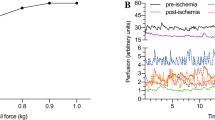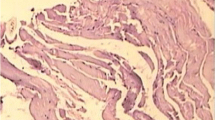Abstract
An experimental group of mice were subjected to a hindlimb tourniquet for 90 min followed by 60 min postischemic reperfusion (ischemia/reperfusion, I/R). Two further groups with the same experimental procedure received allopurinol to inhibit endothelial xanthine oxidase to produce oxygen free radicals (I/R-allo) or vitamin E as a radical scavenger (I/R-vitE). The soleus muscle was examined, and the contralateral muscle served as control. Glutathione (both reduced and oxidized forms, GSH and GSSG) concentrations and the relative protein content were measured. Additionally, the muscles were examined under the electron microscope for pathological alterations. The results showed: (i) the existence of much oxidative stress in the I/R group, but not in the I/R-allo and I/R-vitE groups; (ii) an increased protein content indicative for high capillary permeability in the I/R group, but not in the I/R-allo and I/R-vitE groups; (iii) considerably fewer capillary endothelial disturbances in the I/R-allo and I/R-vitE groups than in the I/R group. We conclude that allopurinol and vitamin E diminished the occurrence of oxidative stress and of edema in postischemic skeletal muscle.
Similar content being viewed by others
References
Blebea J, Cambria RA, DeFouw D, Feinberg AN, Hobson RW, Duran WN (1990) Iloprost attenuates the increased permeability in skeletal muscle after ischemia and reperfusion. J Vasc Surg 12:657–666
Carden DL, Korthuis RJ (1989) Mechanisms of postischemic vascular dysfunction in skeletal muscle: implications for the therapeutic intervention. Microcirc Endothelium Lymphatics 5:277–298
Carvalho FD, Remião F, Vale P, Timbrell JA, Bastos ML, Ferreira MA (1994) Glutathione and cysteine measurements in biological samples by HPLC with a glassy carbon working detector. Biomed Chromatogr 8:134–136
Castillo M, Toledo-Pereyra LH, Shapiro E, Guerra E, Prough D, Frantzis P (1990) Protective effect of allopurinol, catalase or superoxide-dismutase in ischemic rat liver. Transplant Proc 22:490–491
Colburn MD, Gelabert HA, Nowara H, Hajjar GE, Moore WS, Qinones-Baldrich WJ (1994) The effect of hypofibrinogenemia and fibrinolysis on skeletal muscle function after ischemia and reperfusion. J Surg Res 56:77–81
Cronenwett JL, Lee KR, Shlafer M, Zelenock GB (1989) The effect of ischemia-reperfusion derived oxygen free radicals on skeletal muscle calcium metabolism. Microcirc Endothelium Lymphatics 5:171–187
Das DK, Engleman RM, Clement R, Otani H, Prasad MR, Rao PS (1987) Role of xanthine oxidase inhibitor as free radical scavenger: a novel mechanism of action of allopurinol and oxypurinol in myocardial salvage. Biophys Res Commun 148:314–319
Dorion D, Zhong A, Chiu C, Forrest CR, Boyd B, Pang CY (1993) Role of xanthine oxidase in reperfusion injury of ischemic skeletal muscles in the pig and human. J Appl Physiol 75:246–255
Duran WN, Dillon PK (1989) Effects of ischemia-reperfusion injury on microvascular permeability in skeletal muscle. Microcirc Endothelium Lymphatics 5:223–239
Faust KB, Chiantella V, Vinten-Johansen J, Meredith JH (1988) Oxygen-derived free radical scavengers and skeletal muscle ischemic/reperfusion injury. Am Surg 54:709–718
Friesenecker B, Tsai AG, Allegra C, Intaglietta M (1994) Oral administration of purified micronized flavonoid fraction suppresses leukocyte adhesion in ischemia-reperfusion injury: in vivo observations in the hamster skin fold. Int J Microcirc 14:50–55
Gidlöf A, Lewis DH, Hammersen F (1987) The effect of prolonged ischemia on the ultrastructure of human skeletal muscle capillaries. A morphometric analysis. Int J Microcirc Clin Exp 7:67–86
Grace PA (1994) Ischaemia-reperfusion injury. Br J Surg 81:637–647
Idström JP, Soussi B, Elander A, Bylund-Fellenius AC (1990) Purine metabolism after in vivo ischemia and reperfusion in rat skeletal muscle. Am J Physiol 258:H1668-H1673
Jerome SN, Doré M, Paulson JC, Smith CW, Korthuis RJ (1994) P-selectin and ICAM-1-dependent adherence reactions: role in the genesis of postischemic no-reflow. Am J Physiol 266:H1316-H1321
Kawasaki S, Sugiyama S, Ishiguro N, Ozawa T, Miura T (1993) Implication of superoxide radicals on ischemia-reperfusion-induced skeletal muscle injury in rats. Eur Surg Res 25:129–136
Korthuis RJ, Granger DN, Townsley MI, Tayler AE (1985) The role of oxygen-derived free radicals in ischemia-induced increases in canine skeletal muscle vascular permeability. Circ Res 57:599–609
Lowry OH, Rosebrough NJ, Farr AL, Randal RJ (1951) Protein measurement with the folin phenol reagent. J Biol Chem 193:265–275
Massey K, Burton KP (1989) α-Tocopherol attenuates myocardial membrane-related alterations resulting from ischemia and reperfusion. Am J Physiol 256:H1192-H1199
Megison SM, Horton JW, Chao H, Walker PB (1990) High dose versus low dose enteral allopurinol for prophylaxis in mesenteric ischemia. Circ Shock 30:323–329
Menger MD, Pelikan S, Steiner D, Messmer K (1992) Microvascular ischemia-reperfusion injury in striated muscle: significance of “reflow paradox”. Am J Physiol 263:H1901-H1906
Sexton WL, Korthius RJ, Laughlin MH (1990) Ischemia-reperfusion injury in isolated rat hindquarters. J Appl Physiol 68:387–392
Smith JK, Carden DL, Korthius RJ (1989) Role of xanthine-oxidase in postischemic microvascular injury in skeletal muscle. Am J Physiol 257:H1782-H1789
Soussi B, Lagerwall K, Idström JP, Schersten T (1993) Purine metabolic pathways in rat hindlimb perfusion model during ischemia and reperfusion. Am J Physiol 265:H1074-H1081
Sternbergh WC, Adelman B (1992) The temporal relationship between endothelial cell dysfunction and skeletal muscle damage after ischemia and reperfusion. J Vasc Surg 16:30–39
Tomita I, Zhou Y, Ezaki M, Onda T, Tomita T (1992) Vitamin E in protection of oxidative impairment in endothelial and platelet functions. In: Ong ASH, Packer L (eds) Lipid-soluble antioxidants: biochemistry and clinical applications. Birkhäuuser, Basel, pp 65–75
Uhlig S, Wendel A (1992) The physiological consequences of glutathione variations. Life Sci 51:1083–1094
Warren JA, Jenkins RR, Packer L, Witt EH, Armstrong RB (1992) Elevated muscle vitamin E does not attenuate eccentric exercise-induced muscle injury. J Appl Physiol 72:2168–2175
Author information
Authors and Affiliations
Rights and permissions
About this article
Cite this article
Appell, H.J., Duarte, J.A., Glöser, S. et al. Administration of tourniquet. Arch Orthop Trauma Surg 116, 101–105 (1997). https://doi.org/10.1007/BF00434111
Received:
Issue Date:
DOI: https://doi.org/10.1007/BF00434111




